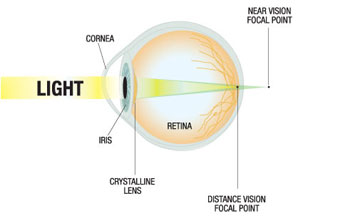Tecnis Multifocial
How the Eye Works
The human eye has two lenses that work together to focus light onto the retina. The outer focusing lens is called the cornea. The inner focusing lens is called the crystalline lens. Light rays pass first through the cornea and then through the crystalline lens.
The cornea and crystalline lens focus incoming light by bending all the light rays to meet at a single point on the retina. From the retina, these light rays are sent as electrical pulses to the brain where our mind "sees" a picture of what's in front of us.
Vision changes with age
The aging process affects the clarity and quality of vision, which may impact a patient's ability to read or drive at night. Two primary causes of vision loss with age are cataracts and presbyopia.
What is a Cataract?
The natural crystalline lens of the eye is made mostly of water and protein. Sometimes in a person's 60s, 70s, or 80s, some of the protein will clump together, causing the eye's natural lens to become discolored and clouded. This clouding of the natural lens is called a cataract.
When this occurs, light rays passing through the eye become scattered and unfocused. The result is that all objects, whether near or far, become blurry. If left untreated, cataracts can lead to blindness, although this is very uncommon in the United States.
CATARACTS

The only treatment for a cataract is removal of the affected natural lens of the eye and implantation of a lens implant, or intraocular lens (IOL). This restores the eye's ability to have light pass unobstructed through to the retina. Over 15 million IOL procedures are performed worldwide each year.
What is Presbyopia?
As we age, the natural crystalline lens in our eye becomes less flexible. This lack of flexibility compromises the eye's ability to switch from one focal point (objects at a distance - driving) to another focal point (objects that are close - reading). This is called presbyopia.
The practical effect of this loss of flexibility in the natural lens of the eye is that we lose our ability to read or see close objects without reading glasses or bifocals.
PRESBYOPIA

Today, for people who have cataracts with or without presbyopia, there is a procedure to remove the affected natural lens of the eye and replace it with an advanced TECNIS Multifocal Lens. This implantable lens provides focused vision in all depths of field - near, intermediate, and far - in all lighting conditions.
TECNIS® Multifocal Lens
Designed to give patients back their youthful vision, the TECNIS Multifocal Lens provides patients with high-quality vision at any distance, and in any light condition - even in low light.
Results
The advanced TECNIS Multifocal is an implantable lens that restores vision after cataract surgery and corrects presbyopia (the need for reading glasses). It's the lens 94% of patients would choose again.
It delivers results superior to those of a standard multifocal lens and offers an excellent chance to become spectacle independent.
Exceptional Full Range of Vision
The TECNIS Multifocal Lens enables a patient to see clearly at near, intermediate, and far distances without glasses in all light conditions.
Compare the following images. In the first image, which demonstrates vision with the TECNIS Multifocal Lens, you can see the coffee cup close up, the dashboard at intermediate, as well as road signs in the distance-all clearly.
Now, compare the second image. This image demonstrates what a patient might see with a monofocal lens. Although the intermediate and distance vision is clear, notice how the coffee cup is now blurry.
Key Statistics
- Nearly 9 out of 10 study patients did not require glasses1
- Excellent image quality at all distances, under any lighting condition2
- Over 94% of study patients would choose TECNIS Multifocal IOL again1
Optimized Design
- Aspheric anterior surface corrects spherical aberration to essentially zero
- Fully diffractive posterior surface for pupil independence
- Proprietary diffractive optic and clear hydrophobic acrylic material for best image quality
Nighttime Driving
Immediately after surgery, some patients may notice rings around lights when driving at night. However, as the eye adjusts to the lens, the visual impression of rings may lessen or go away over time.
Payment Considerations
Medicare now allows greater access to advanced technology lens implants like the TECNIS Multifocal Lens. A recent Medicare ruling on lens implants allows beneficiaries to upgrade to the full range of vision and greater spectacle independence provided by the TECNIS Multifocal Lens. This means the traditional costs associated with cataract treatment are covered by Medicare, with patients having the option to pay additional charges associated with receiving a presbyopia-correcting lens such as the TECNIS Multifocal Lens.
Some private insurance companies are following Medicare's example and allowing patients to upgrade to the TECNIS Multifocal Lens. A patient should contact their physician or insurance provider to learn more about coverage and payment options.
References 1. Terwee T, Weeber H, van der Mooren M, Piers P. Visualization of the retinal image in an eye model with spherical and aspheric, diffractive, and refractive multifocal intraocular lenses. J Refract Surg. 2008;24:223-232. 2. TECNIS Multifocal Foldable Acrylic Intraocular Lens package insert. Santa Ana, CA: Advanced Medical Optics, Inc.
